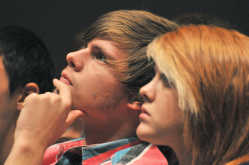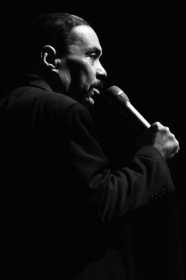Renowned photographer, publisher recalls Parks

FORT SCOTT, Kan. -- John Shearer recalled his memories of Gordon Parks and moments in his career during a special appearance Friday at Fort Scott Community College.
The noted photographer, publisher and recipient of the 2011 Choice of Weapons Award discussed his career, showed slides of his photos and talked about his relationship with Parks during a presentation that was part of this year's Gordon Parks Celebration of Culture and Diversity.
Shearer said he first met Parks, who was a friend of Shearer's father, as a young boy and the two men eventually became lifelong friends and even colleagues at Life magazine.

"Thank you, Gordon," Shearer wrote in a video presentation that played before his talk. "You will always be my hero and my mentor."
Shearer talked about developing a love for photography at a young age and how Parks was one of the major inspirations in his life. Parks encouraged him to "take photographs and write a paragraph every day," which Shearer said was "one of the most wonderful pieces of advice I've ever received in my life."
Shearer also gave some advice to a group of Fort Scott High School photography students who were in the audience.
"It's all about hard work," Shearer said of reaching one's goals. "I became obsessed with taking pictures. I read everything I could. I learned about developing pictures and different kinds of cameras. It was practice, practice and falling in love with it."
He added, "You have to be outgoing to be a photographer. You have to go out and get the photo."
Shearer said Parks also told him that "when you get an opportunity to do something, do your best at it" and to "only show your best work." Parks' voice was "always in the back of my head" during his years at Life magazine, he said.
At the age of 17, Shearer was one of the youngest staff photographers ever hired by a major publication when Look magazine took him on. He was on staff with the magazine from 1966-'69, and covered the race riots and civil rights movement of the 1960s.
He was hired by Life in 1968, where he worked as a staff photographer until the magazine ceased regular weekly publications in 1972. Parks was the first African-American staff photographer at Life magazine and Shearer became the second eight years later.
Shearer's office was located next to Parks' office while working at Life and Shearer learned much from his mentor.
"Life (magazine) was an amazing time," he said. "We had a wonderful group of photographers. I took a look around, I thought, 'I'm part of this.'"
Shearer said photographers at Life received $5,000 to buy cameras and equipment, which was "a lot of money back then."
As a photographer, Parks "always moved his perspective around," changing angles frequently when considering his shots, Shearer said. He said Parks traveled all over the world taking pictures.
"Gordon became a master of telling picture stories," he said. "He constructed them as a writer writes a book."
Establishing a bond with something or someone is "so important in doing a picture story," Shearer said.
Shearer said he tells people who are interested in photography to "not do it because you want to make a lot of money or become famous," but "because you have to do it, you're driven to do it. That's what you have to do with the arts."
Like Parks, Shearer has been a photographer, writer, director, lecturer and professor. He covered several landmark events throughout his career as a photographer, including the funeral of Martin Luther King Jr. and the Attica Prison riot. In 1970, he worked on a story about a South Bronx street gang. He also covered the first Muhammad Ali vs. Joe Frazier bout, billed as the "Fight of the Century."
He was the only photographer allowed inside the maximum security Attica Prison during the assault by New York law enforcement authorities in 1972 and watched events unfold.
"That was an incredible time in my life," he said.
One of Shearer's most famous photographs was taken on Monday, Nov. 25, 1963, the day of John F. Kennedy's funeral. Shearer's historic photo depicts a young John Kennedy Jr. saluting his father's coffin as it departed.
Shearer is scheduled to be honored with the Choice of Weapons Award at a tribute dinner Saturday evening at the Liberty Theatre. The award was established in Parks' honor to be given annually at the celebration. It recognizes those who have excelled in the same areas that Parks did and who exemplifies Parks' spirit and strength of character.
